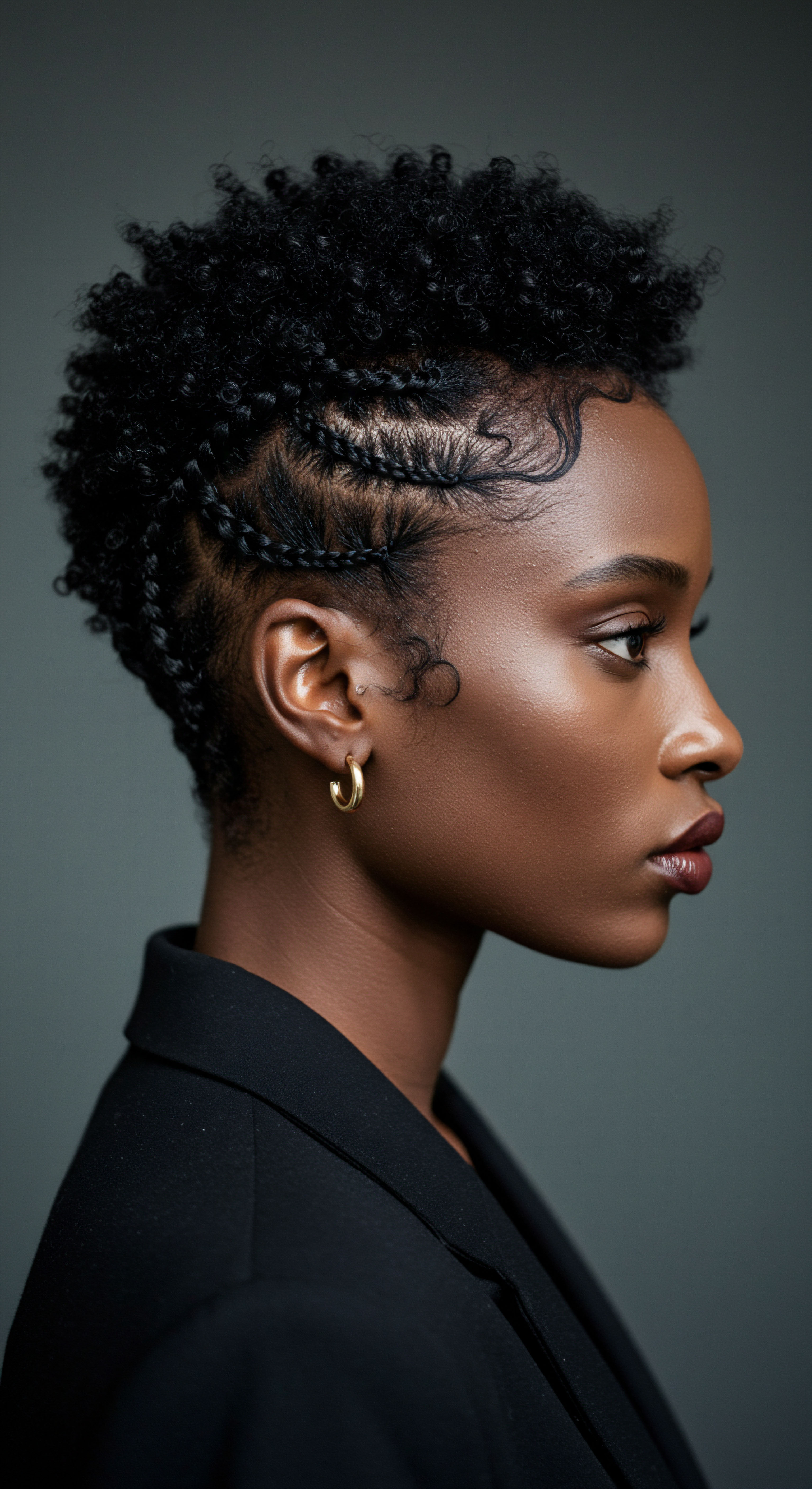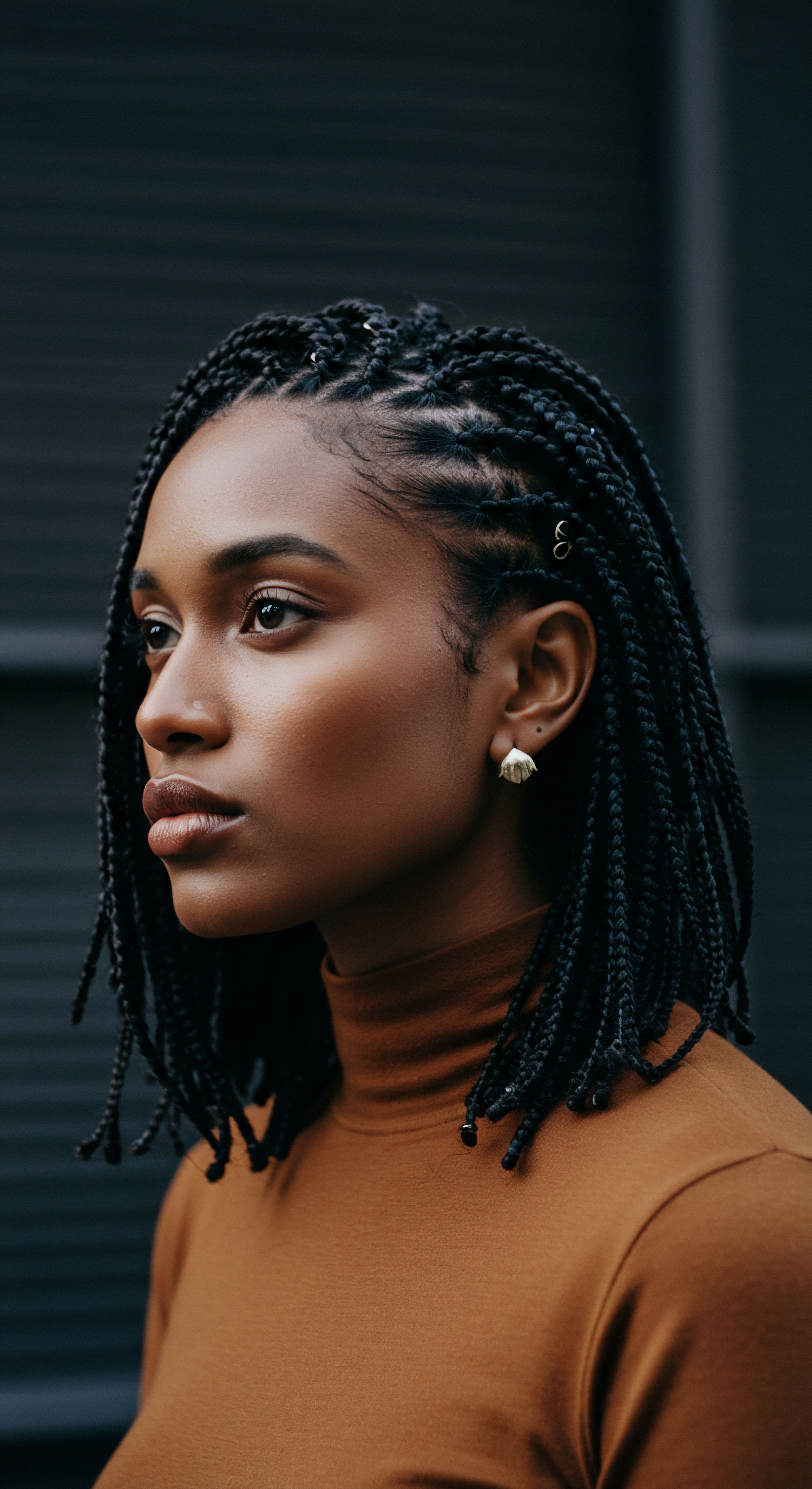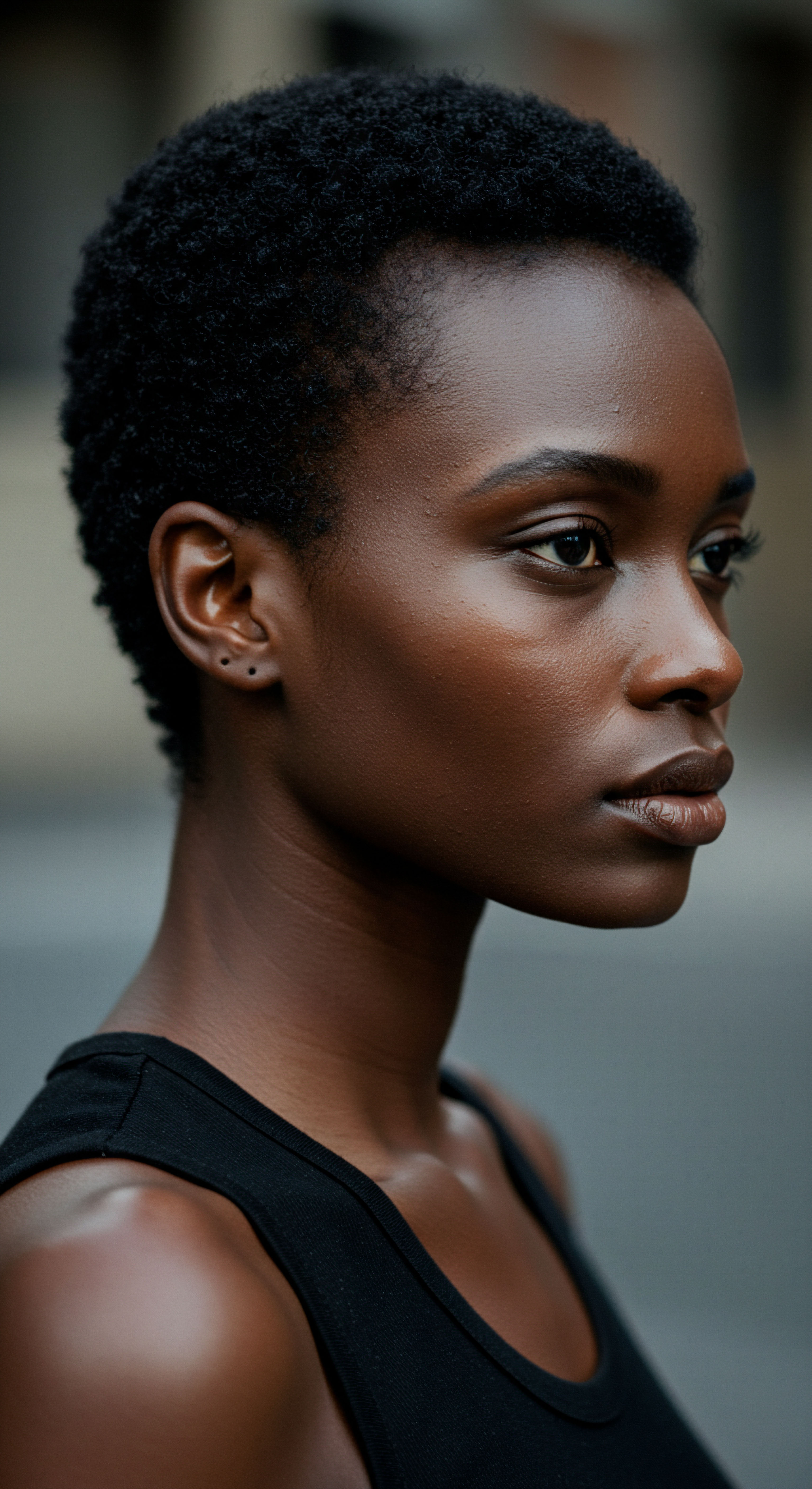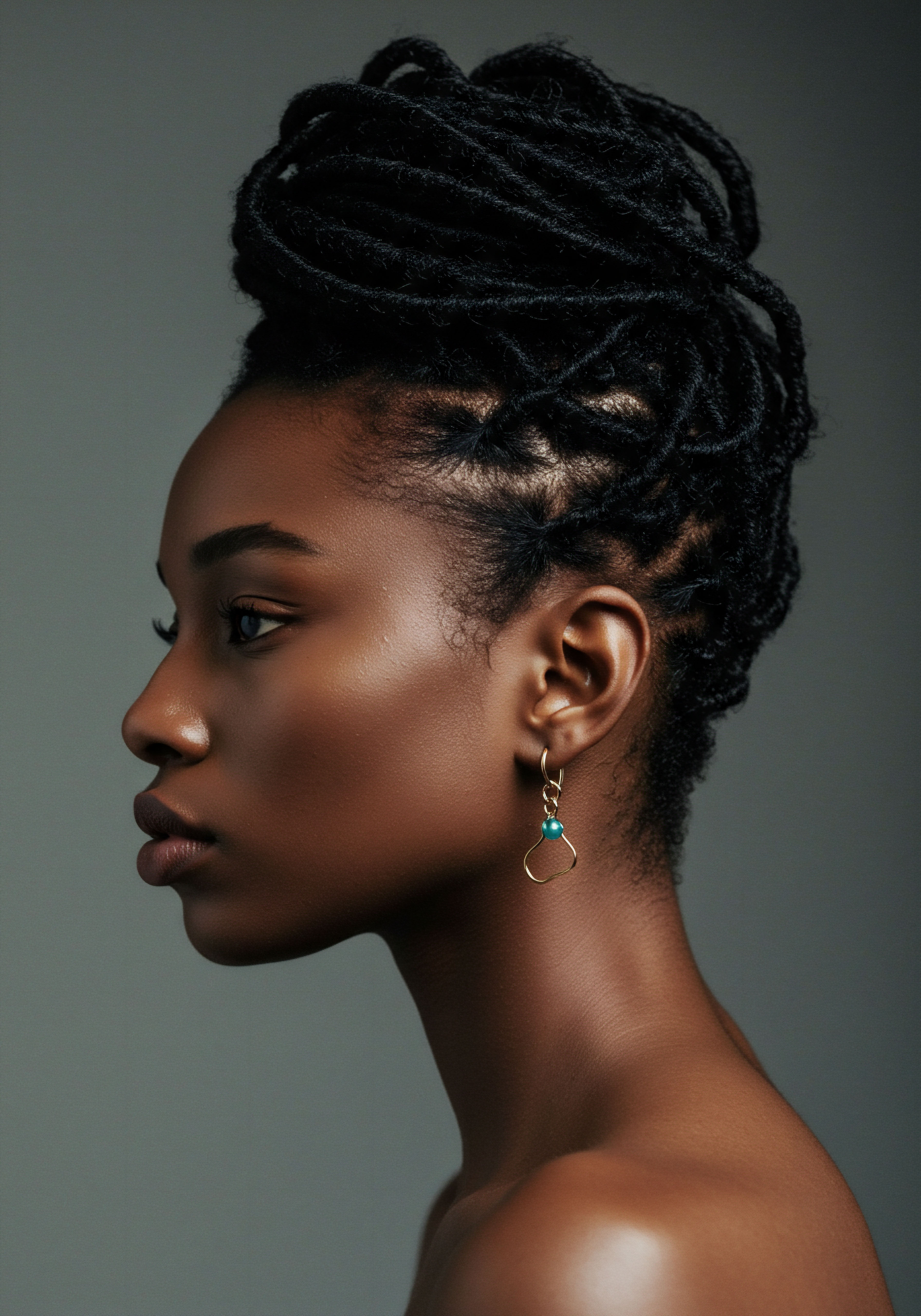
Roots
To truly understand the profound significance of hair care for enslaved peoples, one must first quiet the noise of modern perceptions and listen to the echoes of ancestral wisdom. Consider, for a moment, the hair on your own head ❉ a biological marvel, certainly, but also a canvas of identity, a keeper of stories, and a connection to something far greater than mere appearance. For those forcibly taken from their homelands, hair was not simply a physical attribute; it held within its coils and strands a living memory of who they were, where they came from, and the enduring spirit that refused to be extinguished. It became a silent, yet powerful, testament to an unbroken heritage, a subtle defiance against a system designed to strip away every shred of selfhood.

Hair Anatomy and Physiology Under Duress
The unique helical structure of textured hair, characterized by its elliptical cross-section and distinct cuticle layers, presents a fascinating study in resilience. Unlike straighter hair types, coiled strands possess more disulfide bonds and a greater number of twists along the hair shaft, which contributes to their strength but also their susceptibility to dryness and breakage if not properly tended. When enslaved Africans arrived in the Americas, they were abruptly cut off from the traditional tools, nourishing oils, and communal practices that had sustained their hair for generations.
The brutal conditions of forced labor, exposure to harsh elements, and lack of adequate nutrition meant that hair often became matted, tangled, and severely damaged. This physical deterioration was a deliberate consequence of the enslavers’ intent to dehumanize, severing a vital link to cultural identity.
Hair, in its very structure and care, became a quiet testament to enduring identity amidst brutal attempts at erasure.
Yet, even in such dire circumstances, the hair itself, with its inherent properties, offered a foundation for covert acts of self-preservation. The natural density and spring of textured hair, often deemed “unruly” by oppressors, provided a natural architecture that could be manipulated for purposes beyond mere aesthetics. This innate quality, paradoxically, became a source of strength, a physical characteristic that could not be entirely altered or controlled by external forces.

The Language of Hair Before Chains
Prior to the transatlantic slave trade, hair in African societies was a sophisticated visual language, a living chronicle of an individual’s journey and place within their community. Hairstyles conveyed marital status, age, social standing, ethnic identity, wealth, and even religious beliefs. Elaborate designs, often requiring hours or even days to create, were communal activities, fostering social bonds and transmitting cultural traditions.
This deep cultural connection meant that the act of shaving heads, a common practice upon capture and arrival in the Americas, was a profound act of dehumanization, a deliberate attempt to erase identity and sever ancestral ties. It was an assault on the very essence of personhood, a violent imposition of anonymity.
To strip someone of their hair was to strip them of their story, their place, their voice. The meticulous care and artistry invested in hair in pre-colonial Africa stood in stark contrast to the neglect and denigration forced upon enslaved peoples, highlighting the immense loss and the subsequent acts of quiet defiance.

Why Did Hair Hold Such Meaning in African Societies?
- Identity Marker ❉ Hairstyles signaled an individual’s ethnic group, family lineage, and community affiliations.
- Social Status ❉ Hair could denote wealth, marital status, age, and rank within a society.
- Spiritual Connection ❉ Hair, being the highest point of the body, was often seen as a conduit for spiritual communication and divine messages.
- Communal Bonding ❉ Hair Care rituals were often collective activities, strengthening social ties and allowing for the sharing of knowledge and stories.
The loss of these deeply ingrained practices left a void, but it also spurred a quiet determination to reclaim what was stolen, often through the very medium that had been targeted for destruction.

Ritual
As the relentless sun beat down on the fields and the oppressive weight of bondage pressed upon their spirits, enslaved peoples found quiet moments to reclaim a piece of themselves, often through the very practices that had been denied to them. These were not merely acts of grooming; they were rituals of survival, whispered traditions, and coded communications. The care of hair, once a vibrant public expression, transformed into a private act of self-possession, a subtle assertion of humanity in the face of its systematic denial. It was a space where practical wisdom met enduring cultural memory, offering solace and strength.

Protective Styling as a Shield
The harsh realities of plantation life — grueling labor, inadequate clothing, and exposure to the elements — made traditional hair care nearly impossible. Yet, enslaved women, with remarkable ingenuity, adapted their ancestral knowledge to protect their hair. Styles like cornrows, twists, and knots, which originated in Africa, served a dual purpose ❉ they minimized breakage and tangling, preserving the hair’s health, while simultaneously serving as a cultural anchor. These styles were not simply functional; they were a continuation of heritage, a visual link to the continent they had been torn from.
Headwraps, too, became ubiquitous, offering protection from the sun and dust, but also serving as a canvas for expression and, at times, a cover for the intricate work beneath. The tignon laws in Louisiana, which mandated that Black women cover their hair, ironically led to an even more elaborate and defiant use of headwraps, turning an act of subjugation into a display of personal style and resilience.
Hair care rituals, often performed in secret, became quiet acts of defiance, preserving identity and heritage against overwhelming odds.

Hair as a Coded Map and Archive
Perhaps one of the most striking ways hair care became a form of resistance was through its use as a covert communication system. Oral histories, particularly from Colombia, recount how enslaved women braided complex patterns into their hair to create literal maps for escape routes. A coiled braid might signify a mountain, a sinuous pattern a river, and a thick braid a soldier or a safe house.
Meeting points could be indicated by converging rows of braids. These intricate designs, often overlooked or dismissed as mere aesthetic choices by enslavers, served as silent guides to freedom.
Beyond maps, hair also became a portable archive for survival. Enslaved individuals reportedly hid seeds, grains of rice, or even small gold fragments within their braids. These hidden provisions were vital for sustenance during perilous journeys to freedom, and the seeds, once planted, could help establish new lives in liberated communities.
This practice speaks volumes about the foresight, ingenuity, and profound hope that persisted even in the darkest of times. The hair, thus, was not just a symbol; it was a practical tool for liberation, a testament to the human spirit’s refusal to be contained.

How Did Braids Serve as Secret Communication?
The subtlety of hair patterns made them an ideal medium for discreet communication, a language understood only by those who knew how to read its silent syntax.
- Mapping Routes ❉ Braiding patterns could depict geographical features, indicating safe paths, rivers, or mountains for escape.
- Conveying Information ❉ Specific braid styles, like the “departs” style in Colombia, could signal a planned escape or a meeting time.
- Storing Resources ❉ Seeds, rice, or gold could be hidden within the braids, providing sustenance or currency for those seeking freedom.
These acts, seemingly small, held immense weight, demonstrating a deep, collective will to survive and resist.

Relay
Beyond the visible acts of hair care and the silent language of braids, a deeper current of resistance flowed, one that touched upon the very psychology of selfhood and the enduring power of cultural memory. How did the simple act of tending to one’s hair, or refusing to conform to imposed aesthetics, become a profound challenge to the apparatus of enslavement? This inquiry leads us into the complex interplay of internal resilience, social dynamics, and the subtle subversion of a dehumanizing system. The hair, in its very texture and existence, became a site of contested meaning, a battleground for dignity.

The Psychological Terrain of Hair Identity
The systematic shaving of heads upon arrival, and the subsequent denigration of natural African hair textures as “woolly” or “nappy,” were deliberate strategies to strip enslaved peoples of their identity and instill a sense of inferiority. This psychological assault aimed to disconnect individuals from their ancestral roots and impose a Eurocentric beauty standard. Yet, even within this oppressive framework, acts of hair care became a quiet, powerful assertion of self-worth.
To meticulously detangle, oil, and style one’s hair, even with rudimentary tools and scavenged ingredients like animal fats or butter, was to reclaim agency over one’s body and spirit. It was a refusal to internalize the dehumanizing labels, a defiant affirmation of inherent beauty and personhood.
This act of self-care fostered a sense of community, as women gathered on Sundays—often their only day of rest—to care for each other’s hair, sharing techniques and stories. These communal grooming sessions were not merely practical; they were moments of solidarity, spaces where cultural knowledge was passed down, where collective identity was reinforced, and where a sense of shared struggle and resilience was cultivated.

A Quiet Subversion of Economic Structures
While often overlooked, the very act of engaging in hair care also represented a subtle economic subversion. Time, under slavery, was a meticulously controlled commodity, directly equating to labor and profit for the enslaver. The hours spent tending to hair, even if only on a Sunday, represented time diverted from the master’s direct control, time dedicated to personal and communal well-being. Furthermore, the resourceful procurement and utilization of natural ingredients—from local herbs and plant oils to repurposed animal fats—demonstrated an autonomous resourcefulness that bypassed the imposed economic system of the plantation.
Consider the broader economic implications ❉ the very existence of textured hair, and the need for specialized care, presented a challenge to the uniformity sought by the slave economy. The attempts to force conformity, such as the preference for “straighter hair” for house slaves, reveal an underlying anxiety about the persistent visibility of African identity. This preference, while seemingly offering a “privilege,” was a mechanism of division and control, attempting to fragment the community by creating a hierarchy based on proximity to European features. Yet, the consistent return to and adaptation of traditional hair practices, even in the face of such pressures, underscores a powerful, albeit often unquantified, resistance to the totalizing economic and social control of slavery.
A poignant, albeit less commonly cited, example of hair care’s economic and symbolic defiance lies in the oral histories from parts of South America, particularly Colombia. Here, beyond mapping escape routes, enslaved women would sometimes braid small quantities of Gold Dust or Seeds into their hair. This act was not merely about survival during escape; it was a quiet yet potent reassertion of economic agency and a rejection of their status as mere chattel. Gold, a symbol of wealth and sovereignty in many West African cultures, was literally carried on their heads, a secret treasure defying the enslavers’ claim to all their possessions and labor.
These tiny caches, if discovered, could have led to severe retribution, yet the risk was taken, underscoring the profound symbolic and practical value of such acts. This clandestine movement of resources, however small, represented a micro-economy of freedom, a testament to the ingenuity and enduring spirit of those who sought to break free.

How Did Hair Care Practices Disrupt Dominant Power Structures?
The subtle, persistent nature of hair care resistance worked on multiple levels, undermining the psychological and social control mechanisms of slavery.
| Aspect of Resistance Identity Preservation |
| Description Maintaining traditional styles and textures despite efforts to erase African identity. |
| Impact on Oppression Counteracted dehumanization and psychological subjugation. |
| Aspect of Resistance Covert Communication |
| Description Braiding patterns used to convey escape routes or hidden messages. |
| Impact on Oppression Circumvented literacy restrictions and facilitated escape. |
| Aspect of Resistance Resource Concealment |
| Description Hiding seeds, grains, or valuables within hairstyles. |
| Impact on Oppression Provided sustenance and means for survival post-escape. |
| Aspect of Resistance Time Reclamation |
| Description Devoting time to personal grooming and communal care. |
| Impact on Oppression Reclaimed personal autonomy and time from forced labor. |
| Aspect of Resistance Cultural Continuity |
| Description Passing down hair care techniques and traditions orally. |
| Impact on Oppression Ensured the survival of African cultural practices across generations. |
| Aspect of Resistance These practices, though often hidden, collectively represented a powerful assertion of human dignity and a refusal to yield entirely to bondage. |
The continued practice of hair care, even under the most brutal conditions, highlights a remarkable resilience, a testament to the power of self-determination and the refusal to surrender one’s inner world to the oppressor. It stands as a powerful example of how personal acts can hold profound collective significance.

Reflection
The story of hair care among enslaved peoples is a profound echo, reminding us that even in the most suffocating circumstances, the human spirit finds avenues for expression, for defiance, for holding onto selfhood. It reveals a resilience that transcended the physical chains, finding strength in the very strands that crowned their heads. This history calls us to consider how deeply intertwined our physical appearance is with our identity, and how acts of personal care can, in their quiet persistence, become revolutionary. It is a story not of victimhood, but of profound ingenuity, of a cultural heritage that bent but did not break, a testament to the enduring power of self-possession against a backdrop of systematic oppression.

References
- Byrd, Ayana, and Lori Tharps. Hair Story ❉ Untangling the Roots of Black Hair in America. St. Martin’s Press, 2001.
- Johnson, A. & Bankhead, C. The Politics of Black Women’s Hair. Cornerstone, 2014.
- Piesie, Kofi. Africa’s Hair ❉ Before, During And After Slavery. Independently published, 2023.
- Dabiri, Emma. Twisted ❉ The Tangled History of Black Hair Culture. HarperCollins, 2020.
- Robinson, M. The Politics of Black Women’s Hair. University of Michigan, 2011.
- Bellinger, K. The Power of Hair ❉ The Politics of Hair in the African American Community. 2007.
- Thompson, Cheryl. Black Women and Identity ❉ What’s Hair Got to Do With It? 2009.
- Nabugodi, Mathelinda. Afro Hair in the Time of Slavery. Studies in Romanticism, 2022.
- Vargas, Lina María. Sociologist cited in “How frizzy hair saved the lives of slaves”. Noireônaturel, 2024.
- Bristol, K. Knights of the Razor ❉ Black Barbers in Slavery and Freedom. 2009.